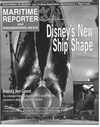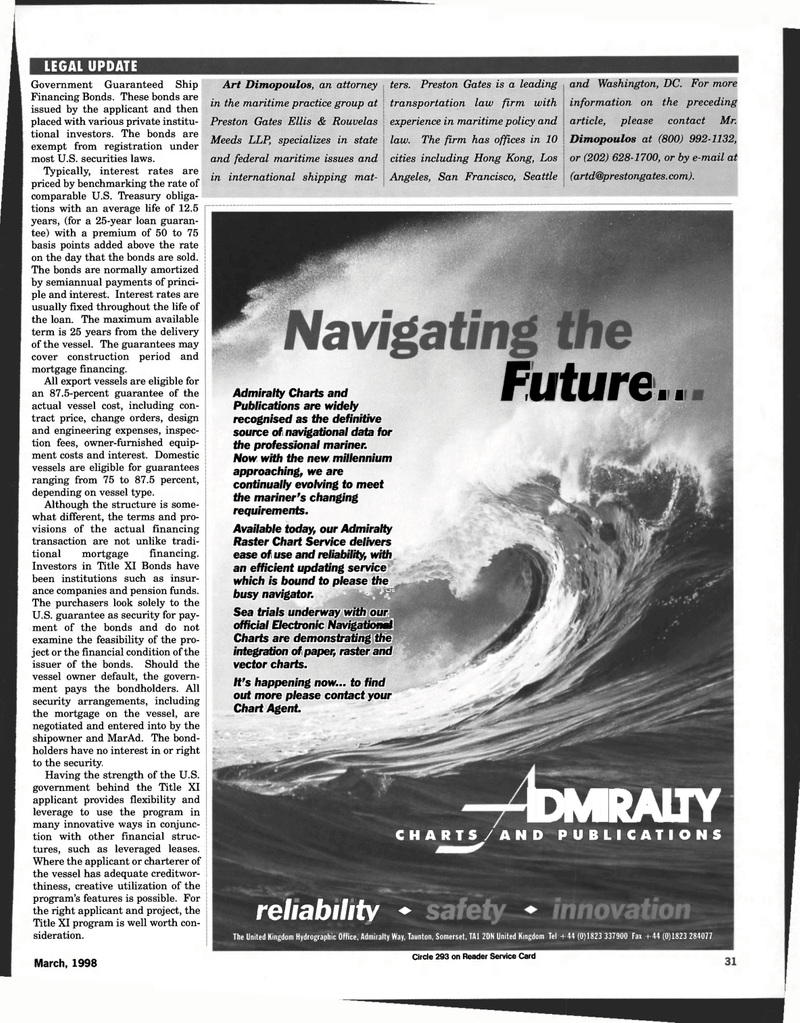
Page 33: of Maritime Reporter Magazine (March 1998)
Read this page in Pdf, Flash or Html5 edition of March 1998 Maritime Reporter Magazine
LEGAL UPDATE
Government Guaranteed Ship
Financing Bonds. These bonds are issued by the applicant and then placed with various private institu- tional investors. The bonds are exempt from registration under most U.S. securities laws.
Typically, interest rates are priced by benchmarking the rate of comparable U.S. Treasury obliga- tions with an average life of 12.5 years, (for a 25-year loan guaran- tee) with a premium of 50 to 75 basis points added above the rate on the day that the bonds are sold.
The bonds are normally amortized by semiannual payments of princi- ple and interest. Interest rates are usually fixed throughout the life of the loan. The maximum available term is 25 years from the delivery of the vessel. The guarantees may cover construction period and mortgage financing.
All export vessels are eligible for an 87.5-percent guarantee of the actual vessel cost, including con- tract price, change orders, design and engineering expenses, inspec- tion fees, owner-furnished equip- ment costs and interest. Domestic vessels are eligible for guarantees ranging from 75 to 87.5 percent, depending on vessel type.
Although the structure is some- what different, the terms and pro- visions of the actual financing transaction are not unlike tradi- tional mortgage financing.
Investors in Title XI Bonds have been institutions such as insur- ance companies and pension funds.
The purchasers look solely to the
U.S. guarantee as security for pay- ment of the bonds and do not examine the feasibility of the pro- ject or the financial condition of the issuer of the bonds. Should the vessel owner default, the govern- ment pays the bondholders. All security arrangements, including the mortgage on the vessel, are negotiated and entered into by the shipowner and MarAd. The bond- holders have no interest in or right to the security.
Having the strength of the U.S. government behind the Title XI applicant provides flexibility and leverage to use the program in many innovative ways in conjunc- tion with other financial struc- tures, such as leveraged leases.
Where the applicant or charterer of the vessel has adequate creditwor- thiness, creative utilization of the program's features is possible. For the right applicant and project, the
Title XI program is well worth con- sideration.
Art Dimopoulos, an attorney in the maritime practice group at
Preston Gates Ellis & Rouvelas
Meeds LLP, specializes in state and federal maritime issues and in international shipping mat- ters. Preston Gates is a leading transportation law firm with experience in maritime policy and law. The firm has offices in 10 cities including Hong Kong, Los
Angeles, San Francisco, Seattle and Washington, DC. For more information on the preceding article, please contact Mr.
Dimopoulos at (800) 992-1132, or (202) 628-1700, or by e-mail at (artd@prestongates. com).
Admiralty Charts and
Publications are widely recognised as the definitive source of navigational data for the professional mariner.
Now with the new millennium approaching, we are continually evolving to meet the mariner's changing requirements.
Available today, our Admiralty
Raster Chart Service delivers ease of use and reliability, with an efficient updating service which is bound to please the busy navigator. £gg
Sea trials underway with our official Electronic Navigational
Charts are demonstrating the integration of paper, raster and vector charts.
It's happening now... to find out more please contact your
Chart Agent.
Future..
IDMIRALTY
CHARTS/AND PUBLICATIONS reliability •
The United Kingdom Hydrographic Office, Admiralty Way, Taunton, Somerset, Tfll 2DN United Kingdom Tel +44 (0)1823 337900 Fax +44 (0)1823 284077
March, 1998 Circle 293 on Reader Service Card

 32
32

 34
34
